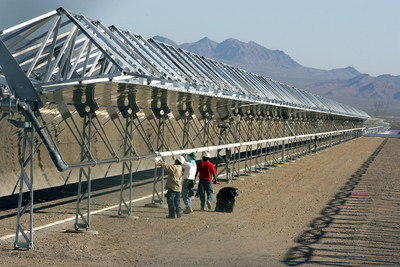Nevada utility finally meets state’s solar-energy mandate

Looks like all that sun finally paid off.
When Nevada enacted a 1997 mandate requiring the state’s electric utilities to weave renewable energy into their tapestry of power sources, it seemed like an easy goal to meet in a state blessed with sunlight and geothermal hot spots.
Just one obstacle blocked the way.
Neither Nevada nor the rest of the Southwest had the alternative-energy plants to meet the standard as it ticked up each year. The result: NV Energy and its two subsidiaries, Nevada Power Co. in the south and Sierra Pacific Power Co. in the north, missed at least part of the renewable-portfolio standard year after year.
On Wednesday, though, NV Energy reported a breakthrough. The utility’s officials told the Nevada Public Utilities Commission they met the entire guideline in 2008, when their operation was scheduled to get 9 percent of its electricity from renewable sources rather than fossil fuels such as coal and natural gas.
Tom Fair, NV Energy’s vice president of renewable energy, credited the achievement to a passel of project completions.
“Sometimes you get a spurt of activity and things come to fruition in a rather major way,” Fair said.
Past attempts to reach the renewable-portfolio goal fell short partly because generating plants weren’t finished on time, and partly because NV Energy wanted renewables that weren’t too expensive for consumers. Issues ranging from difficulties obtaining environmental permitting to finding financing prevented numerous plants from coming online.
Funding uncertainties, in particular, could make for problems going forward; the banking sector’s meltdown in late 2008 has made cash for development scarce, so builders and operators delayed some projects.
Fair said he’s not yet certain whether those projects will be there to help NV Energy meet the 2009 guideline calling for the utility to obtain 12 percent of its power from renewables.
Nevada’s portfolio standard mandates that power utilities here get 20 percent of their energy from renewables by 2015.
NV Energy has 35 renewable projects in its portfolio, including eight in planning and four under construction. Most of its alternative sources in Southern Nevada come from the sun.
The company buys solar power from eight local plants, including the 64-megawatt Nevada Solar One in Boulder City and the 14-megawatt photovoltaic plant near Nellis Air Force Base.
Both provide enough electricity to power roughly 70,000 homes. Nationwide, only Southern California Edison and Pacific Gas and Electric Co. derive more power from solar energy than NV Energy obtains.
In Northern Nevada, NV Energy focuses on geothermal plants, which generate electricity from heat below ground. Officials on Wednesday dedicated two big geothermal plants in Fallon that will supply NV Energy. The plants can serve 40,000 homes.
NV Energy also buys alternative energy from hydroelectric sources and plants that tap into waste heat from industrial plants.
It’s codeveloping a 200-megawatt wind farm in northeastern Nevada. Plus, energy conservation measures count toward the portfolio standard.
Since 2004, NV Energy has nearly doubled the amount of renewables it buys or produces, Fair said. Throw in conservation measures, and the company has more than doubled its alternative sources in the last five years.
Sean Sever, a spokesman for the Public Utilities Commission, said the agency will issue findings on NV Energy’s report by April 29.
Contact reporter Jennifer Robison at jrobison@reviewjournal.com or 702-380-4512.












